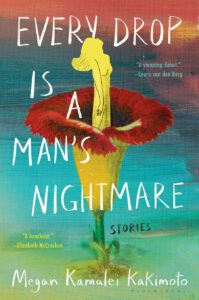
I first met Megan Kamalei Kakimoto in 2021 at the Tin House Winter Workshop, where I encountered an earlier version of her story, “The Love and Decline of the Corpse Flower.” I fell in love with its haunting grief narrative, which involves the transfiguration of a corpse flower on a couch. I’ve since become familiar with Megan’s work through the Michener Center for Writers, where she was a third-year student while I was a first. Now she has released her poignant and fantastical debut collection of short stories, Every Drop is a Man’s Nightmare (Bloomsbury Publishing, 2023).
Kakimoto’s collection brims with themes of the difficult womanhood of girls, sisters, mothers, daughters, and lovers: women who are told they “were never right.” And yet, drawing on Hawaiian mythology and folklore, the characters in Every Drop is a Man’s Nightmare resist physical and emotional alienation, colonization, and category. They resist “fixing.” They revel in their bodies, in fraught companionship, in raw humor, in love and lust, in blood, in stories that serve as warnings and incantations, stories that protect and confine. From the superstitions in the opening story to the final piece about an unforgettable corpse flower, I was engulfed in a complex world created by a fearless writer.
It was a joy to talk to Kakimoto over Zoom about ancestral storytelling, language, humor, dangerous caregiving, writing women’s bodies, the pressure to “get it right,” and those haunting corpse flowers.
***
The Rumpus: Mythology and superstitions are deeply embedded in this collection. What is your relationship to these superstitions and legends, and how have they shaped you as a writer?
Megan Kamalei Kakimoto: The legends and myths of Hawaiʻi and Hawaiian culture have operated as a low vibration or hum that’s in the background of a lot of my early life and development. I think it’s because so many of these stories are ubiquitous in Hawaiian culture. When I’ve talked to readers who are from here or who are Hawaiian, they’ve expressed how reading the superstitions awakens this long dormant thing they haven’t thought about for years. They read a sentence and it’s back. I just spoke with someone recently about putting your chopsticks in your rice bowl straight upright—a superstition shared across cultures—and it returned them to their childhood. This was similar to my experience writing these stories. I grew up around all these stories, and in fiction, I was able to explore them more deeply.

Rumpus: In the title story, “Every Drop is a Man’s Nightmare,” there’s a point when the main character’s family worries that she knows too much about her heritage, as if they want to protect her from it. Did the superstitions and ancestral stories you inherited ever hold your characters back?
Kakimoto: I think that inherited stories in this collection are both a gift and a burden. I’m especially interested in how some of these characters are trying to build lives of their own and how these inherited stories fit into those lives. How do these stories fit into who they are? How do they figure into the lives they are trying to lead? Sometimes, they’re going against these superstitions and tempting the consequences. Maybe even testing them. I think a lot of the stories, whether or not I realized it at the time, might have started from that kernel of questions, and then I followed the characters.
Rumpus: Are characters being pushed to reckon with their own assumptions about these stories?
Kakimoto: I definitely think so. That’s a great observation, and another thing I’ve been thinking about lately: how to articulate the significance of superstitions that might feel or sound silly. There are a lot of ways to portray these superstitions because so many are connected to deeper ancestral stories and to Hawaiian culture and history and religion. It’s a question for me of how to articulate the gravity and weight of superstitions. What I enjoyed in writing these stories is that for some characters, the superstitions operated at a low level in their lives, a passing mention. With other characters, they had to reckon with doing what their mother or their grandmothers said not to do and sit with the consequences. Being able to explore superstitions in that way was exciting and challenging.
Rumpus: How do you see language connected to this process? Throughout these stories, ‘ōlelo, the indigenous language of Hawaiʻi, is woven into the prose. What has been your relationship to ‘ōlelo and how do you see it working in these stories? What are some of the challenges?
Kakimoto: The language of ‘ōlelo was primarily oral, which is something I’m currently exploring in my novel. Missionaries, when they arrived, turned ‘ōlelo into a written medium in order to enable Hawaiians to read the Bible. I’m not fluent in ‘ōlelo. While there aren’t as many people who are fluent in ‘ōlelo as there once was, there’s also a lot of really great work being done to reclaim the language and to teach ‘ōlelo in schools.
I was committed, in these stories, to focus on my experience of the language. There’s a lot of pressure on people who are writing from a marginalized community to summarize that experience in their writing. In my case, this is true from the Hawaiian experience. I was focused on depicting my personal experience, my own childhood, youth, adult life, community, and especially the maternal side of my family. I was a very quiet, observational child, and I absorbed a lot of the dialogue around me and how people spoke to each other. That was the experience I was hoping to bring to these stories. I didn’t want to pander in any way or write into a language that I’m vocal about not being fluent in, just for the sake of making it a “Hawaiian book.” I wanted to be true to my own experience of the language. So there’s English, ‘ōlelo, and pidgin, which isn’t really a marriage of the two but a conversational dialect that so many of my family members and family friends speak. That’s what’s most natural to me.
Rumpus: There are certain words that feel deeply interwoven with English. Like “keiki,” which means child. Is that your experience of it?
Kakimoto: Yes. If someone says “keiki,” most people know what that means. Not to speak for the larger community, but it’s definitely one of those words that’s common in casual conversation.
Rumpus: The language was rendered on the page with diacritical marks in places. Was that easy to get through the publishing process? Easy to advocate for?
Kakimoto: On the publishing side, Bloomsbury was great about it. They didn’t push any glossing or italicizing of words or incorporating a glossary. With the diacritical marks for a lot of the words, I was very comfortable spelling and rendering on the page. I was also able to work with another former high school classmate of mine fluent in ‘ōlelo who read the manuscript and provided his notes on it. His guidance was really valuable.
Rumpus: The trauma of colonization is often a complicated undercurrent in these stories. In “Touch Me Like One of Your Island Girls: A Love Story” Mehana, the main character, is reclaiming her body and desire while profiting from the commodified gaze of native women. It’s impossible for them to escape colonization and objectification, and yet the characters aren’t reduced to victimhood. Pamela, Mehana’s friend, says: “Might as well wring out some pleasure for ourselves while we still can, right?” How do you see Mehana and Pamela wringing out this pleasure?
Kakimoto: Mehana is a character who lives so much in her head—I like writing characters who exist a lot in their heads—but she also has a body. She’s trying to come to terms with what it’s like to exist in her body, where her body is in space, what that means in a colonized land. The whole story is about striving to find contentment in your space and world but discovering that so much of that contentment resides in contentment with yourself. I think the love story aspect was more of a personal journey for Mehana to embrace her own existence.
Rumpus: Mehana’s story is also an example of a funny story in which traumatic things happen. Many of the stories have this quality. There are times when I’m laughing out loud and then the next page, I’m gut-punched. How do you use humor in these stories?
Kakimoto: I don’t think I’m naturally a funny person! In life outside of writing, I’m a people-pleaser by nature, and I tend to avoid humor that could be insensitive or that might hurt another person. But in writing, there is a lot of freedom to experiment. When it comes to humor, it’s a part of the writing process for me. So many of the themes I was interested in exploring are heavy and important, and they deserve that weight, and yet I didn’t have the stomach to write a brutal and bleak collection. Some of my favorite moments and scenes are when characters do something surprising that bends toward humor or something selfless that reaches for connection. Those moments of compassion and humor felt necessary for telling these stories. It’s what I like writing about—displaying that full range of a person’s humanity. So the humor was integral to these stories from the start. I appreciate you saying that they’re funny because I love reading and writing humor.
Rumpus: There are a lot of dualities in this collection, especially in the female relationships. Care and harm live very close together. The care of mothers, sisters, friends, and lovers is not defanged. The women are not just maternal figures, and friendship isn’t just kindness. Care is complex, like the mother of Toby in “Madwomen,” who wrestles with how to raise her son. Her love is both protective and destructive. How did the element of danger come up for you as you were writing?
Kakimoto: This might be too much of a process-y answer, but while writing in general and writing about these women, from the start many of them made bad choices and/or had messy lives. I wanted to bring those characters and decisions to the forefront. It was only after hearing from people who read the stories—not just in the publishing process, but readers—that I got feedback about the thread of danger. I didn’t think about these choices as dangerous in the writing process, and that’s a good thing. If I was aware of it, I might have had the impulse to self-censor what I was interested in or how I wrote into the characters. I’d have fear about how the stories might be perceived. I don’t dislike the danger comments. I find it complimentary and appreciate it.
Rumpus: Women’s bodies are described with vivid detail in terms of fluids and blood. Did looking closely at mythological stories, like that of Pele, the Hawaiian fire goddess who has a lot of power and sexual energy, influence how you wrote about women’s bodies?
Kakimoto: I gravitate toward works of fiction that look unflinchingly at bodies, what bodies can do and what they endure. When it comes to writing about women’s bodies in particular, I’ve paid attention to how Hawaiian culture approaches men and women’s bodies with less division. There are female Hawaiian warriors and men who are caregivers of keiki. In “Every Drop Is a Man’s Nightmare,” the title story, I thought a lot about menstruation. I was interested in studying hale peʻa, the place where Hawaiian women went to rest during their periods away from men and children. This wasn’t a separation mandated because of some impurity—that’s already such a powerful thing—it was for rest. I feel a lot of gratitude to come from a culture that has this in its foundation. It emboldened a lot of opportunities to write into women’s bodies in a way that’s stripped of fear and shame.
Rumpus: In the meta story “Aiko, the Writer,” the main character, Aiko, is a writer who has written a manuscript about the Night Marchers, an army of warrior spirits that protect the islands. The manuscript is literally vibrating, and there’s the voice of her grandmother forbidding Aiko from writing about the Night Marchers and warning her to be careful with how vulnerable she is making these stories by letting them be seen by outsiders. As a writer, how did you contend with that weight?
Kakimoto: The fear of getting it right was twofold. First, I had to feel confident enough to share these stories with an audience that wasn’t necessarily going to be only a local or Hawaiian audience. Could I write stories that could be read and hopefully understood by other readers?
The more pressing fear of getting it right was with my own community. I worried about depicting a single or monolithic Hawaiian experience. In my rational brain, I know that’s not a thing, that’s not realistic, but I feared nonetheless I would be asked to represent a “Hawaiian” experience. Early on, this fear stifled so much of my writing, not just about Hawaiian characters but also about setting stories in Hawaiʻi. All through undergrad and the years after undergrad, I wrote stories set in Montana or Durham, North Carolina, because those were places I had spent some time in. I was scared of writing about Hawaiʻi, and I don’t think that fear has fully left me. I’ve been conscious of thinking about the heart of the story. What’s the story I need to tell? Trying to let individual characters guide [the story’s] trajectory, rather than letting my fear of missteps or getting a story “wrong” infiltrate the process. The fear of being policed, not only by white readers, but by your own community, can be a terrifying thing for any writer writing from a marginalized experience. It can keep a lot of people from writing the stories that they need to write. I hope we can champion the full range of Hawaiian stories. Our stories matter and that’s important to me.
Rumpus: These stories encompass a broad range in terms of voice, tone, elements of horror, and magic realism. When you start writing, what gets you into the process?
Kakimoto: I think it has evolved for me a bit. I used to say I started with tone. It felt like something I really needed to get right from the start. Not necessarily from the first line, but while imagining the story, I needed to get the atmosphere right. I think that still stands, but a few stories started with an image, like of a corpse flower, not in an arboretum, but on a couch. There were some images that I observed or imagined that were slightly off kilter that I wrote into and then the characters followed. A couple stories started with the voice and character, like “Madwomen.” The voice of the mother in that story felt fully realized to me before I had a draft.
Rumpus: Have you ever smelled a corpse flower?
Kakimoto: I finally did! It was well after the collection was completed. It was outrageous! The flower was huge, maybe five or six feet across, though technically it was a smaller one. This was at the University of California Santa Cruz, and it had been blooming for only twenty-four hours. It smelled of weeks-old trash, very corpse-like. It was the coolest thing!
***
Author photo by Van Wishingrad




